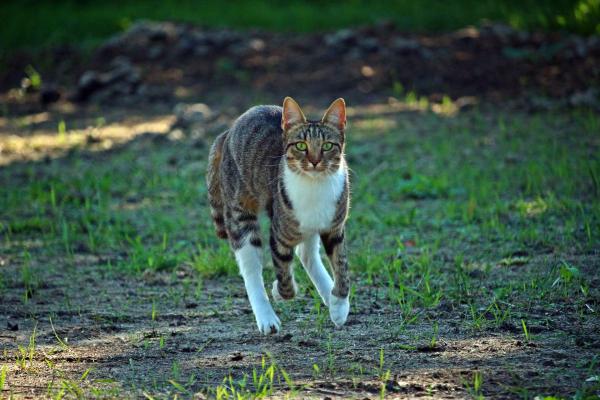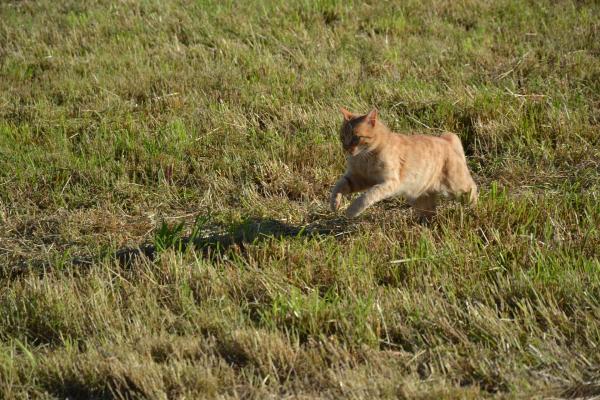
Cats can run very fast, making it difficult for humans to catch them if they run somewhere they shouldn't. They can dart about easily through our legs and even run up vertical surfaces with seemingly little effort. Although they have great speed in small spaces, does this mean cats can run faster than humans?
At maximum velocity, cats can run faster than humans. However, the difference in speed is not great. More acute is the way in which their bodies have developed to create an aptitude for running which humans cannot emulate. To better understand the reason for a cat's agility and speed, AnimalWised dissects how a cat runs and why they can outrun humans in some ways, but not others.
How do cats run?
One of the first things we should know is that cats run differently than they walk. This has to do with their gait which changes according to the speed at which they move. An animal's gait is the movement of their limbs as they move across land. For cats, they have something called a ‘pacing gait’. A pacing gait involves the cat keeping their paws in a straight line when walking, moving the legs from one side around the other as they step. This is relatively rare in mammals and is partly how cats have such good balance on narrow walkways such as the tops of fences.
When a cat picks up speed, their gait changes. It changes from this pacing gait to something called a ‘diagonal gait’. This is where the diagonally opposite legs on the hind and front quarters move at the same time. It allows them to run more freely, but they have less steadiness than if they were walking.
The pacing gait means they are great at stalking, something which is different to dogs. A study at Duke University in 2008 showed a reason why this might be the case[1]. Their conclusion was that cats have a gait which is not the most efficient for running, but is perfect for sneaking up on prey. Wild dogs who might be more inclined to chase across open plains are generally faster, but do not engage in stalking in the same manner.

How fast can a cat run?
As with humans, there are many different factors which affect a cat's speed. For example, a cat's weight will slow them down as they run, as will a broken limb or a medical condition such as feline hip dysplasia. Unlike humans, we don't tend to record individual cat speeds. Even with dogs, Greyhound racing gives us a better idea of how fast individual dogs can run.
One study which does seem to provide relatively accurate results exists in the book Do Cats Always Land on Their Feet by Becker and Spadafori[2]. In this book the top speed of a cat was clocked at 48 kph which is just over 30 mph.
When we compare this to the fastest unassisted land speed record by a human, we see that the fastest we humans could muster is 44.72 kph or 27.8 mph. This was by Olympian Usain Bolt in 2009, but we can see it is not that far away from a cat's top recorded speed.
While Bolt is the current fastest human being ever recorded, we don't know if the cats used in Becker and Spadafori's study can say the same in feline terms. What it does show us is that breed seems to have a factor, leading us to ask what is the fastest cat breed in the world?
As we said, recorded study is limited, but the fastest breed in the book is the Egyptian Mau. Stockier breeds with shorter limbs or more rounded ones like the American Shorthair will not necessarily be able to run as fast, but the differences likely aren't massive and will depend on the individual cat. In the book, the Savannah, Abyssinian, Oriental and more are considered some of the fastest domestic cat breeds in the world.
How fast a cat can run is important since it increases the risk of escape. Even if they have a good life indoors, some cats may still try to run away. Learn more about this phenomenon with our article on whether cats come back if they run away.

Why can cats outrun humans?
While we know that cats are indeed faster than humans on average, we may not know why this is so. The reasons are to with the way our bodies are compared to felines. These differences concern:
- How cats walk: human beings are types of plantigrade animals. This means we walk with our toes flat on the ground. It allows us to stand upright and keep our stamina. Cats are digitigrade animals which means they walk on their toes. This allows them to move more quickly across the ground, just as humans sprint on the balls of their feet. A cat's ankles are higher which provides them with a smoother movement. While this structure allows them to sprint better, a human has better endurance. Flat-footed walking provides better support over long distances, making continuous movement more amenable. A cat may win in a 100 m sprint, but humans would likely fare better in a marathon.
- How cats run: as we said earlier, a cat's gait changes when they move from walking to running. Their running gait is at full speed when they are in a double suspension gallop. This is called a double suspension as over the course of one full gallop, all of the cat's legs will be completely off the ground (i.e. suspended in the air). This means they have little friction or air resistance and are propelling themselves very efficiently. Greyhounds and Whippets used as racing dogs also employ this technique for running, although they are more efficient. Humans only have two limbs which touch the ground when running, so they don't have as much push compared to an animal with four.
- Balance: a cat has incredible balance which means it can land well and adapt to the ground as they run[3]. Their digitigrade feet also afford them this ability. This is partly why cats can evade humans so well. As much as they are faster, they can also better adapt to their environment.
- Flexibility: another reason cats are able to run faster than humans is their flexibility. The Cheetah is the fastest land animal reaching speeds of up to 60 mph. The fastest recorded Cheetah, named Sarah, clocked in at 61 mph (91 kph)[4]. The Cheetah has a flexible spine which rotates in such a way that their front and back legs overlap, giving them the ultimate efficiency when it comes to running. While not as fast, the domestic cat also has a more flexible spine which allows them to run in a similar way.
- Claws: cats also have claws which can use when they require traction to run quicker. This is why humans use cleats on their shoes to be able to give them the traction we don't naturally possess.
The reason why cats have developed the ability to run faster than humans is a question for evolutionary theorists. However, our human ability to walk upright might make us slower, but being so high on the food chain, we can still manage to make our way through the world.

If you want to read similar articles to Can Cats Run Faster Than Humans?, we recommend you visit our Facts about the animal kingdom category.
1. Duke University. (2008, December 4). Dogs Chase Efficiently, But Cats Skulk Counterintuitively. ScienceDaily. Retrieved May 9, 2023 from www.sciencedaily.com/releases/2008/12/081203184533.htm
2. Becker, M., & Spadafori, G. (2010). Do Cats Always Land on Their Feet? Hachette, UK.
https://books.google.es/books/about/Do_Cats_Always_Land_on_Their_Feet.html?id=NFQ07VEQKV0C&redir_esc=y
3. Musienko, P., Courtine, G., Tibbs, J. E., Kilimnik, V., Savochin, A., Garfinkel, A., Roy, R. R., Edgerton, V. R., & Gerasimenko, Y. (2012). Somatosensory control of balance during locomotion in decerebrated cat. Journal of neurophysiology, 107(8), 2072–2082.
https://doi.org/10.1152/jn.00730.2011
4. Smith, R. (2012). Cheetah Breaks Speed Record—Beats Usain Bolt by Seconds. Retrieved from:
https://www.nationalgeographic.com/science/article/120802-cheetah-sarah-cincinnati-zoo-fastest-record-science-usain-bolt-olympics